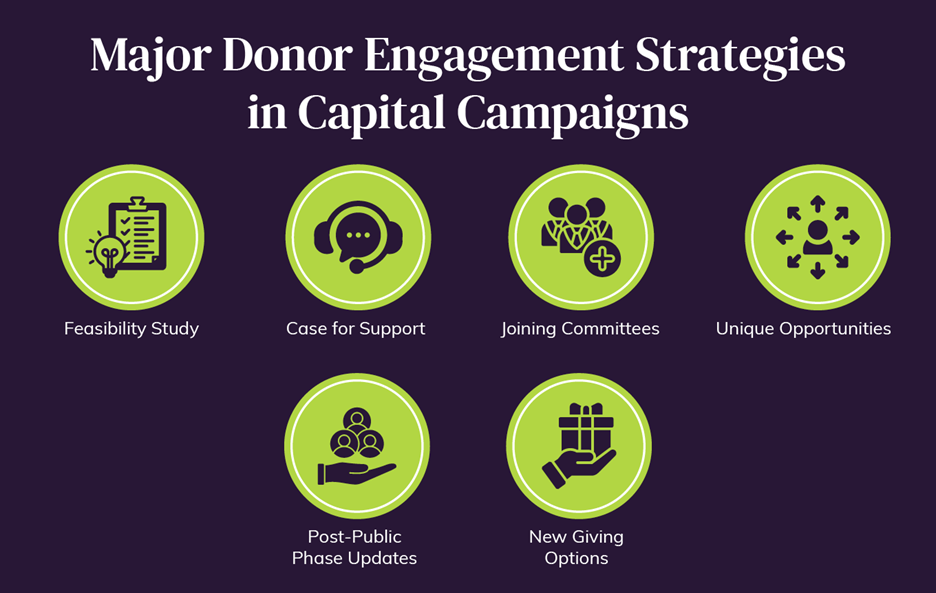Engaging Major Donors in a Capital Campaign: 6 Tactics

Capital campaigns are the ultimate opportunity to engage your most essential supporters and deepen their connections to your mission.
Let’s say you’re heading into a major campaign. You’ll assess your board’s risk tolerance, establish your initial plans, conduct fresh screening and qualification exercises, and tighten up your prospect portfolios. Once your campaign is underway, you’ll get in touch with these prospects to explain your objective and ask them for gifts.
But think beyond the ask—if a major donor gives or is likely to give a sizable contribution, they’ve bought into the importance of your campaign and would probably be thrilled to take their impact even further. How can you actively use your capital campaign to engage major donors and deepen their involvement with your cause?
Let’s review a few top recommendations for major donor engagement strategies.

- Involve them in your feasibility study.
- Work with them to test your case for support.
- Ask them to join key committees.
- Look for unique involvement opportunities.
- Keep them in the loop beyond the public phase.
- Identify new giving options for future follow-up.
1. Involve them in your feasibility study.
Before moving forward with a capital campaign, you’ll conduct a feasibility study (also called a campaign planning study) to test your initial plans and working goal. In it, a third-party expert will interview a range of individuals who will play roles in your campaign, including:
- Major donors
- Funding organizations
- Internal stakeholders like organizational leadership and frontline fundraisers
- External stakeholders like constituents and corporate partners
These interviews serve to gauge these stakeholders’ thoughts on your plan and preliminary case for support. Paired with prospect research and internal readiness assessments, an effective feasibility study will show you a clear path forward for a successful campaign.
Multiple major donors and prospects will be invited to participate, but be intentional with who you and your consultant choose to involve. If you expect that an individual will play a lead or significant role in your campaign’s quiet phase, make sure they’re on the list.
The feasibility study is an early and quite valuable opportunity to not only ask key supporters for their input but also show that you value it. Show donors that their thoughts will directly shape the campaign’s roadmap. This will help secure their early buy-in and kickstart conversations about the campaign and their gift.
2. Work with them to test your case for support.
During the feasibility study, major donors and prospects will be presented with your campaign’s preliminary case for support.
At this stage, your vision for growth and impact should be solid, with objectives and working goals that give supporters a clear sense of what you’ll need to get there. But your case for support is far from set in stone—you’ll be able to continue refining it throughout the campaign.
Once you’ve begun discussing your campaign with lead donors and prospects, ask them for feedback on your approach and case for support.
Use their thoughts to further refine your case for support throughout the campaign’s quiet phase, and learn more about how you might personalize your asks to prospects of different ages, interests, and relationship lengths.
For instance, if you interview both an older and younger donor in your feasibility study, compare their impressions of your case for support and what they found to be its most compelling elements. Use these insights to inform your approach as you talk with diverse prospects throughout the rest of the campaign.
3. Ask them to join key committees.
For those donors who express extra interest in your campaign, like longtime major donors thrilled about your new objectives, look for ways to get them directly involved by serving on a committee. Depending on donors’ commitment and your own assessment of appropriateness, these committees might include:
- Steering committee
- Nucleus fund committee, if they’re open to making introductions for your team or even helping with solicitations
- Kickoff committee, especially if they’re open to serving as campaign ambassadors (more on this strategy below)
- Ad hoc committees for promotions and press, sponsorships, etc.
If it becomes clear that a donor would be interested in playing a larger role in pushing the campaign forward, ask about their interests. Lay out the ways that you think they’re uniquely positioned to help, such as by making introductions, hosting kickoff events, or donating services.
4. Look for unique involvement opportunities.
Depending on the unique context of your campaign and relationships with donors, all kinds of opportunities might arise for deeper engagement. For example, if a supporter expresses interest in getting out front for your cause, brainstorm some creative ways to empower them. One option is to serve as a public ambassador or advocate for your project by:
- Hosting or cohosting events
- Leading peer-to-peer fundraising initiatives (which can be especially helpful leading up to larger campaign-related events like galas)
- Exploring, securing, and promoting new corporate sponsorships
In other cases, donors might prefer to keep a low profile. Opportunities like matching fundraising challenges and making corporate introductions can be a quieter way to drive a big impact.
At the very least, you can encourage donors to share their stories—what your cause means to them, why they’re excited about your organization’s vision, and more.
Consider your fundraising context, too. In education and hospital grateful patient fundraising, for example, personal stories can be extremely compelling and garner positive attention for your campaign. An alumnus of a university or independent school might be motivated by “paying it forward” for a new generation. Chances are other alumni feel the same way, making this a highly impactful story for your campaign to share.
Take the time to talk to your donors about their motivations and connections to your work and to gauge their comfort level with public involvement. If you do suggest unique engagement opportunities, make sure they’re fully tailored to each individual.
5. Keep them in the loop beyond the public phase.
Once your capital campaign officially ends and you reach your final goal, your relationships with the major donors who helped you get there don’t end—why keep them out of the loop of the amazing progress they’ve enabled?
After all, while a burst of gratitude from your team immediately following the campaign is certainly appreciated, radio silence as your funded project picks up steam won’t be. Donor recognition is already an integral part of capital campaigns, with ribbon cuttings, dinners, thank-you calls, and wall installations being the norm for many organizations.
However, you should look for ways to go further. Keeping donors updated and involved during the follow-through phase will reinforce the connections and feelings of personal investment that the campaign fostered. This might take the form of:
- Providing donors with regular progress updates via email and phone calls
- Inviting them to periodic site visits
- Asking to meet for casual catch-ups and to share updates in person
Treat donors as valued partners who you’ve worked with to achieve something momentous. Long-term engagement must be actively fostered, but this doesn’t always mean elaborate events and glossy invites—small gestures and one-on-one outreach go a long way.
6. Identify new giving options for future follow-up.
The ultimate goals of fostering long-term engagement and retention with your major donors are to 1) strengthen the relationship over time and 2) to lay the groundwork for continued giving.
Major donors might give large donations fairly infrequently, and capital campaigns come around even less frequently. However, as you learn more about your donors, you can find opportunities for future solicitations that won’t come off as premature by considering non-cash gifts.
The world of non-cash giving is exploding today, with more donors than ever expressing interest in giving via:
- Their estate and financial plans through bequests, trusts, and annuities
- Grants from donor-advised funds (DAFs)
- Gifts of stock and other appreciated securities
- Qualified Charitable Distributions (QCDs) from IRAs
- Beneficiary designations on life insurance policies or unused retirement assets
What makes these gifts good opportunities to consider for your continued relationships with major donors? They can offer extra value to your donors that might not be available with traditional gifts of cash or cash pledges, namely unique tax benefits and financial planning flexibility.
This makes non-cash gifts helpful options to suggest when you know that they align with a donor’s circumstances and philanthropic goals. Or, you can incorporate them into your next major gift or campaign ask as a way for donors to broaden their impact without necessarily giving out of pocket. Non-cash giving could even be incorporated into a secured donor’s campaign pledges over time if agreed to in advance.
Before, during, and after your capital campaign, keep these non-cash gift options in mind. In the course of your conversations, ask donors whether they have a DAF and what kinds of financial goals are on their radar. As always, keep careful track of your touchpoints and insights, even those learned after a typical campaign gift has been secured.
________________________________________________________________________________________
Capital campaigns inherently rely on the support of major donors to drive amazing results, but they’re more than a time to ask for support—they’re full of opportunities to deepen your relationships in all kinds of ways.
Stay on the lookout to identify these opportunities, and take the time to deeply learn about your donors’ interests and motivations.
Aaron Dahlstrom is the Vice President of Digital Marketing at Graham-Pelton. Creative and considerate, Aaron plans and executes Graham-Pelton’s presence across all digital mediums, ensuring that those who invest their time engaging with the firm experience the timely thought leadership and bold approach audiences have come to appreciate.

